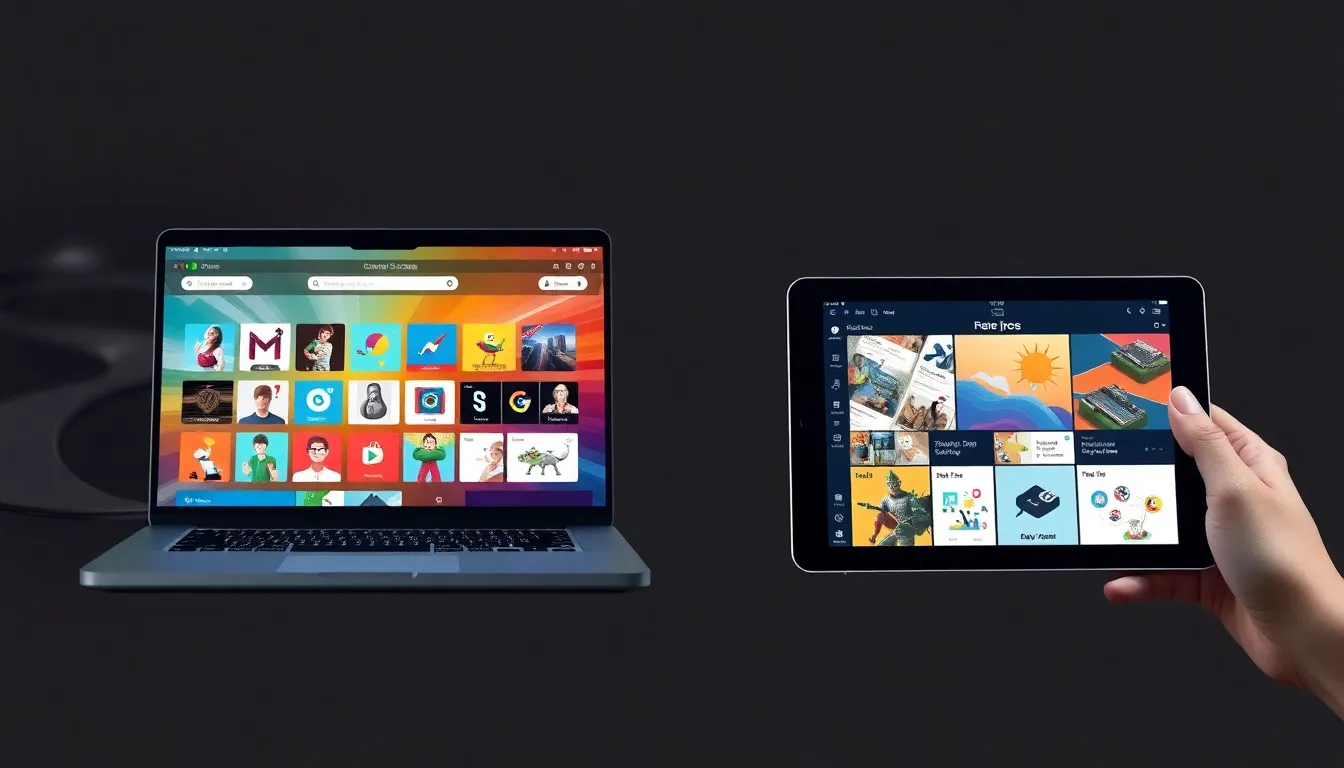Table of Contents
ToggleIn today’s digital age, software marketplaces have transformed the way businesses and consumers access technology. These platforms serve as vibrant hubs where developers showcase their products and users discover solutions tailored to their needs. With a vast array of applications available, navigating this landscape can feel overwhelming, yet it opens doors to innovation and efficiency.
Software marketplaces not only streamline the purchasing process but also foster competition among developers, driving quality and creativity. As users seek tailored solutions, understanding the dynamics of these platforms becomes essential. From popular giants like the Apple App Store to niche players, each marketplace offers unique advantages and challenges. Exploring these environments reveals insights into how software is bought, sold, and utilized in everyday life.
Overview of Software Marketplace
Software marketplaces serve as digital platforms for software developers and users. They facilitate the distribution and acquisition of software applications by offering a centralized location where developers can display their products. Users benefit from a diverse range of technology solutions tailored to their needs.
Several key characteristics define software marketplaces:
- Discovery: Users easily find applications through intuitive search functions and categorized listings. They can explore various software options suited to their specific requirements.
- Purchasing: Streamlined payment systems enable users to purchase software quickly and securely. Transparent pricing structures contribute to user satisfaction.
- User Reviews: Feedback from other users provides insights into software performance. Reviews help potential buyers make informed choices and encourages developers to improve their products.
- Updates and Support: Many marketplaces offer automatic updates, ensuring users access the latest features and security enhancements. Additionally, developers can provide ongoing support through the platform.
Different software marketplaces cater to varied audiences. Major platforms, such as the Apple App Store and Google Play, target a broad consumer base. In contrast, niche marketplaces focus on specific industries or software types. Understanding the specific offerings and challenges within each marketplace aids developers and users in making strategic decisions.
Overall, software marketplaces drive innovation, enhance competition, and improve the quality of software products available to users. Their structure fosters collaboration between developers and consumers, benefiting the technology ecosystem.
Types of Software Marketplaces

Software marketplaces can be classified into two main categories: general marketplaces and niche marketplaces. Each type serves distinct purposes, providing various options for users and developers.
General Marketplaces
General marketplaces accommodate a wide array of software applications across multiple categories. These platforms attract a diverse user base seeking various solutions. Examples include:
- Apple App Store: Offers applications for iOS devices, featuring tools, games, and productivity software.
- Google Play Store: Focuses on Android applications, including mobile games, entertainment, and utility apps.
- Microsoft Store: Provides applications for Windows operating systems, featuring both desktop and mobile software.
General marketplaces excel in offering extensive search and filter options, aiding users in discovering products that meet their needs. Developers find significant visibility here, driving competition and innovation.
Niche Marketplaces
Niche marketplaces focus on specific industries, software types, or user needs. These platforms cater to targeted audiences, providing specialized solutions. Examples include:
- Envato Market: Serves the creative community, offering themes, graphics, and audio files.
- Creative Market: Focuses on design assets, such as fonts, templates, and graphics.
- AppExchange: Targets Salesforce users, offering specialized applications that enhance business processes.
Niche marketplaces provide tailored experiences and foster stronger relationships between developers and users, promoting quality and relevance in applications. They enable developers to reach specific markets and users to find solutions tailored to their unique requirements.
Key Features of Software Marketplaces
Software marketplaces offer critical features that enhance user experience and streamline software acquisition. These features address both user needs and developer capabilities, ensuring a dynamic environment for technology solutions.
User Interface and Experience
User interface (UI) and user experience (UX) play vital roles in software marketplaces. An intuitive layout facilitates product navigation, enabling users to find software efficiently. Features like advanced search filters, categories, and sorting options allow users to refine their searches based on specific requirements. Visual elements, such as screenshots, videos, and ratings, help users make informed decisions quickly. Additionally, responsive design ensures compatibility across various devices. Overall, an engaging UI/UX fosters user satisfaction and encourages repeat visits.
Payment and Licensing Options
Flexible payment and licensing options drive user engagement in software marketplaces. Multiple payment methods, including credit cards, digital wallets, and pay-per-use models, cater to a broad audience. Licensing choices, such as perpetual licenses, subscriptions, and free trials, provide users with various ways to access software. Transparent pricing structures enhance trust, while clear terms of service clarify user rights and developer obligations. These options not only improve user experience but also promote long-term relationships between developers and their customers.
Benefits of Using a Software Marketplace
Software marketplaces offer numerous advantages for both developers and users, enhancing the overall software acquisition experience. The following sections outline key benefits.
Accessibility and Variety
Accessibility stands as a crucial benefit of software marketplaces. Users gain access to a vast array of software applications, covering different categories and functionalities. They can explore solutions tailored to their specific needs, whether for productivity, design, or development. Marketplaces like the Apple App Store and Google Play Store feature millions of apps, making it easy for users to find innovative tools. Developers also benefit from exposure to a global audience, increasing download potential and user engagement.
Simplified Purchase Process
A simplified purchase process significantly enhances user experience in software marketplaces. Users can browse, compare, and purchase applications seamlessly, often with just a few clicks. Secure payment gateways protect user information, fostering trust throughout the transaction. Many marketplaces also support various payment methods, making acquisition convenient for users. With features like one-click installation and automatic updates, users enjoy a hassle-free experience that encourages software adoption and boosts developer recognition.
Challenges and Considerations
Software marketplaces face various challenges that developers and users must navigate. Understanding these potential hurdles ensures informed decisions when engaging with these platforms.
Security Concerns
Security remains a critical issue for software marketplaces. Developers often grapple with protecting their intellectual property from unauthorized use or replication. Users face the risk of downloading malicious software that can compromise their devices or personal data. Many platforms implement security measures, such as encryption and authentication protocols, to safeguard both sides. However, vigilance remains crucial, as no system is entirely immune to breaches. Regular updates and user education about recognizing potential threats enhance overall security in these environments.
Quality Control
Quality control presents another significant challenge within software marketplaces. An influx of applications can lead to varied standards in functionality and performance. While many marketplaces implement review and approval processes, inconsistency may still arise, resulting in subpar applications reaching users. Developers must focus on maintaining high standards by following best practices and adhering to marketplace guidelines. Users rely on ratings and reviews as indicators of quality, though misinformation can distort perceptions. Effective quality control measures, including robust testing and user feedback mechanisms, contribute to a better overall experience in software marketplaces.
Future Trends in Software Marketplaces
Software marketplaces will continue to evolve, shaping the way developers and users interact. Various trends are emerging that will significantly influence this landscape.
Increased Use of Artificial Intelligence
Artificial intelligence (AI) increasingly plays a vital role in software marketplaces. AI enhances search algorithms, providing personalized recommendations to users based on their behavior and preferences. AI-powered chatbots improve customer support, offering instant assistance to users navigating the marketplace.
Emphasis on Subscription Models
Subscription models gain popularity, allowing users to access software on a recurring basis rather than a one-time purchase. This approach provides cost-effective solutions for users and helps developers secure consistent revenue streams. Many platforms will adopt tiered subscription options, offering various features and benefits for different user needs.
Expansion of Niche Marketplaces
Niche marketplaces will expand further, catering to specific industries such as healthcare, finance, and gaming. By addressing unique requirements, these platforms enhance user satisfaction and attract targeted audiences. This specialization allows developers to build stronger relationships with users.
Enhanced Security Measures
As concerns about cybersecurity grow, software marketplaces will adopt enhanced security measures. Multi-factor authentication and blockchain technology will become standard practice, providing greater protection for developers and users. Regular security audits will ensure compliance with evolving standards and protections.
Integration of IoT and Cloud Solutions
The integration of Internet of Things (IoT) applications and cloud solutions into software marketplaces will increase. Users will seek new software compatible with their connected devices, while developers will need to design apps that operate seamlessly across platforms. This connectivity enhances user experiences and expands market reach.
Focus on User Feedback and Reviews
The importance of user feedback and reviews will continue to grow. Marketplaces will implement advanced mechanisms for collecting genuine user experiences. Trustworthy reviews will influence purchasing decisions, driving developers to prioritize quality and customer satisfaction.
Improved Data Analytics
Data analytics will become crucial for both developers and users. Developers can leverage data insights to understand user behavior, preferences, and market trends. Users will benefit from informed recommendations based on their usage patterns, enhancing the overall experience.
Cross-Platform Compatibility
Cross-platform compatibility will be a priority. Users expect applications to function across various devices and operating systems. Developers will focus on creating software that meets this demand, ensuring consistent user experiences regardless of the platform.
Sustainability Initiatives
Sustainability will gain traction in the software marketplace. Developers increasingly prioritize eco-friendly practices in their software development processes. This emphasis attracts users who value environmentally responsible solutions, driving competition among developers to adopt sustainable practices.
Software marketplaces are reshaping the way users and developers interact in the digital landscape. They provide a platform for discovering innovative solutions while fostering competition and driving quality improvements. As these marketplaces evolve they’ll continue to enhance user experiences through advanced features and tailored offerings.
With the rise of niche platforms and the integration of AI technologies the future looks promising. Developers and users alike can expect a more personalized and secure experience. As the ecosystem matures it’s crucial for stakeholders to stay informed and adapt to the changing dynamics of software marketplaces. Embracing these trends will lead to better software solutions and stronger connections within the tech community.




